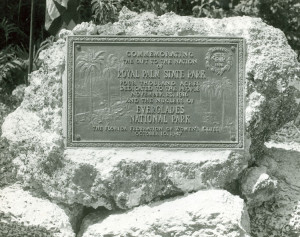We’re headed into the wet season, thankfully. Florida has experienced a very dry winter. It’s been so dry that fires were lighting up across the state burning down acres and acres of trees. In the beginning of May, there were 125 active fires across the state burning around 31,000 acres. Since the start of the new year, the Sunshine state has experienced 2,000 fires. The Florida Department of Agriculture and Consumer Affairs Commissioner said on May 8th, “Florida is in the middle of its worst wildfire season in years – with no end in sight.”
Although these fires are destructive to both wildlife and people throughout the state, there are, believe it or not, benefits to some fires occurring in the ecosystem of the Everglades. Below, we wanted to share with you some information from the National Park Service on the benefits of fire to the Everglades.
For the Pinelands area of the Everglades, fires that come through this area kill off the hammock species that would end up overpowering pines and many other plants. The hammock species create so much shadow covering that the other plants receive no sunlight and die off. Pinelands respond well to fires that come through and bounce back quickly.
Hammocks have also adapted to fires and can protect themselves from burning out completely from fires. These hammocks are surrounded by wet depressions and are moist deep inside, which can help deter fires.
Fire always helps keep the grassy areas on prairies in check. When there is too much grass, it’s harder for the water to properly flow through the Everglades. With coastal prairies, fires maintain a diverse and balance ecosystem so mangroves and exotic plants don’t overwhelm other plants and areas. These fires are not near where people live, but they are still monitored.
Fire can be alarming and unhealthy for people and the environment, but they can also help keep a balanced ecosystem. Officials and firefighters work hard to fight and monitor all fires in the state, so the environment and buildings get the least amount of damage as possible.
If you’ve never been to the Everglades, a great way to experience this wetland is through an airboat tour. You’ll be able to see the ecosystem up-close-and-personal. Captain Mitch’ Everglades Airboat Tours has been giving tours to people in this wetland for more than 30 years. To book a tour. Click here or call 800-368-0065.
 The Everglades is vast, and it has so many different areas for people to explore. One such area is Royal Palm State Park. This Park was established in 1916, but it was surveyed back in 1847 by Jack Jackson. Scientists studied the area and it became known for its botanical diversity and hammock.
The Everglades is vast, and it has so many different areas for people to explore. One such area is Royal Palm State Park. This Park was established in 1916, but it was surveyed back in 1847 by Jack Jackson. Scientists studied the area and it became known for its botanical diversity and hammock. In December, President Obama signed a bill that authorized $2 billion to go towards restoration efforts in the Everglades. This bill was called The Water Infrastructure Improvements for the Nation (WIIN) Act of 2016. This act provides half the funding needed for the Central Everglades Planning Project, and the other half of the funding will come from Florida.
In December, President Obama signed a bill that authorized $2 billion to go towards restoration efforts in the Everglades. This bill was called The Water Infrastructure Improvements for the Nation (WIIN) Act of 2016. This act provides half the funding needed for the Central Everglades Planning Project, and the other half of the funding will come from Florida. Did you know cacti and succulents grow in the Everglades? Surprising, right? These plants don’t just grow in deserts. In fact, many grow in tropical and subtropical climates. The species, native to the Everglades, thrive off the frequent rainfall and the sunny dates. They require a balance of wet and dry conditions.
Did you know cacti and succulents grow in the Everglades? Surprising, right? These plants don’t just grow in deserts. In fact, many grow in tropical and subtropical climates. The species, native to the Everglades, thrive off the frequent rainfall and the sunny dates. They require a balance of wet and dry conditions. What is a false killer whale? Well, its name is misleading. The false killer whale isn’t actually related to the killer whale, but rather, it’s a member of the dolphin family. This dolphin is also known as ‘blackfish.’ In mid-January, 95 dolphins stranded themselves on a remote coast along Hog Key in the Everglades National Park. Despite rescue efforts, 82 of the dolphins died. According to the National Oceanic and Atmospheric Administration, this event is the largest mass stranding of fall killer whales ever in Florida. Many of the whales were deeply stuck in the mangroves and it was extremely difficult for rescue efforts to be successful. The last time a stranding occurred was back in 1986 when 3 false killer whales out of a group of 40 were stranded close to Cedar Key.
What is a false killer whale? Well, its name is misleading. The false killer whale isn’t actually related to the killer whale, but rather, it’s a member of the dolphin family. This dolphin is also known as ‘blackfish.’ In mid-January, 95 dolphins stranded themselves on a remote coast along Hog Key in the Everglades National Park. Despite rescue efforts, 82 of the dolphins died. According to the National Oceanic and Atmospheric Administration, this event is the largest mass stranding of fall killer whales ever in Florida. Many of the whales were deeply stuck in the mangroves and it was extremely difficult for rescue efforts to be successful. The last time a stranding occurred was back in 1986 when 3 false killer whales out of a group of 40 were stranded close to Cedar Key. In the United States, the National Parks are some of the last places left in the country that provide true, natural darkness at night. This darkness makes for ideal stargazing opportunities. The Everglades is an ideal place to view a starry sky, while also providing a perfect nocturnal habitat for hundreds of creatures. The wildlife relies on the Park’s natural lightscape for navigation, and knowing when to hide from predators.
In the United States, the National Parks are some of the last places left in the country that provide true, natural darkness at night. This darkness makes for ideal stargazing opportunities. The Everglades is an ideal place to view a starry sky, while also providing a perfect nocturnal habitat for hundreds of creatures. The wildlife relies on the Park’s natural lightscape for navigation, and knowing when to hide from predators. At the end of last year, a study was released revealing that the bottlenose dolphins in the Everglades show signs of mercury poisoning. Florida International University (FIU) scientists have been examining the dolphins, and released the study that stated the dolphins have a high mercury concentration on both their skin and blubber. These dolphins that were examined live around the Everglades National Park, the lower Florida Keys, and Florida Bay. These dolphins have a high mercury concentration them than any other dolphin population in the world. In fact, the level of mercury these scientists found was the highest level ever recorded.
At the end of last year, a study was released revealing that the bottlenose dolphins in the Everglades show signs of mercury poisoning. Florida International University (FIU) scientists have been examining the dolphins, and released the study that stated the dolphins have a high mercury concentration on both their skin and blubber. These dolphins that were examined live around the Everglades National Park, the lower Florida Keys, and Florida Bay. These dolphins have a high mercury concentration them than any other dolphin population in the world. In fact, the level of mercury these scientists found was the highest level ever recorded. It’s officially the dry season in the Everglades and Florida, which is the best time to head down to the area to view an array of different wildlife species. During this time of year, the good weather combined with low water levels creates the perfect conditions and environment for animals and birds to congregate near bodies of water.
It’s officially the dry season in the Everglades and Florida, which is the best time to head down to the area to view an array of different wildlife species. During this time of year, the good weather combined with low water levels creates the perfect conditions and environment for animals and birds to congregate near bodies of water. Burmese pythons are well-known to be a major problem in the Everglades; however, there are other invasive species in this vast wetland that are a problem to the local ecosystem. One such species is the tegu lizard, which originated in South America. In fact, they are on the state’s list of most aggressive invasive species. So, how did the tegu lizards end up in the Everglades in Florida? They either escaped or were released from people who owned them as pets.
Burmese pythons are well-known to be a major problem in the Everglades; however, there are other invasive species in this vast wetland that are a problem to the local ecosystem. One such species is the tegu lizard, which originated in South America. In fact, they are on the state’s list of most aggressive invasive species. So, how did the tegu lizards end up in the Everglades in Florida? They either escaped or were released from people who owned them as pets.





